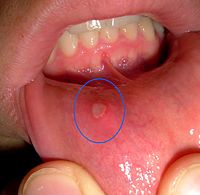
Photo from wikipedia
ObjectiveTo evaluate the variability of clinical treatment and outcomes based on reporting of diabetic foot ulcer MRI findings of adjacent marrow T2 hyperintensity with normal T1 signal.Materials and methodsA retrospective… Click to show full abstract
ObjectiveTo evaluate the variability of clinical treatment and outcomes based on reporting of diabetic foot ulcer MRI findings of adjacent marrow T2 hyperintensity with normal T1 signal.Materials and methodsA retrospective review was conducted of 46 MRI examinations evaluating diabetic foot ulcers that demonstrated normal T1 marrow signal, but T2 marrow hyperintensity deep to the ulcer. The cohort was divided based on MRI report impressions into three groups; “osteitis without osteomyelitis” (OW), “osteitis but cannot exclude early osteomyelitis” (OCEO) and “early osteomyelitis” (EO). Patient demographics (age, gender) and accessory MRI findings of ulcer and sinus tract depth were recorded. Initial clinical assessment and medical treatment (route and duration of antibiotics), healing versus disease progression and histology or microbiology results were recorded.ResultsThe isolated marrow T2 signal hyperintensity was reported as OW in 12 patients, OCEO in 18, and EO in 16. No statistical difference in clinical assessment was demonstrated between the OW, OCEO, and EO groups. Pathological condition was available in 15 patients within 0–7 days (mean 2.4 days) of the MRI examination, with 14 (93%) of these positive for osteomyelitis by histopathology or positive cultures. Initial diagnosis of or progression to osteomyelitis was shown in 28 patients (61%).ConclusionTreatment of suspected osteomyelitis is heavily determined by clinical factors. Patients who initially demonstrate only T2 marrow signal abnormality under a diabetic ulcer are eventually diagnosed as osteomyelitis in 61% of cases and deserve aggressive treatment as early osteomyelitis when meeting clinical parameters.
Journal Title: Skeletal Radiology
Year Published: 2017
Link to full text (if available)
Share on Social Media: Sign Up to like & get
recommendations!